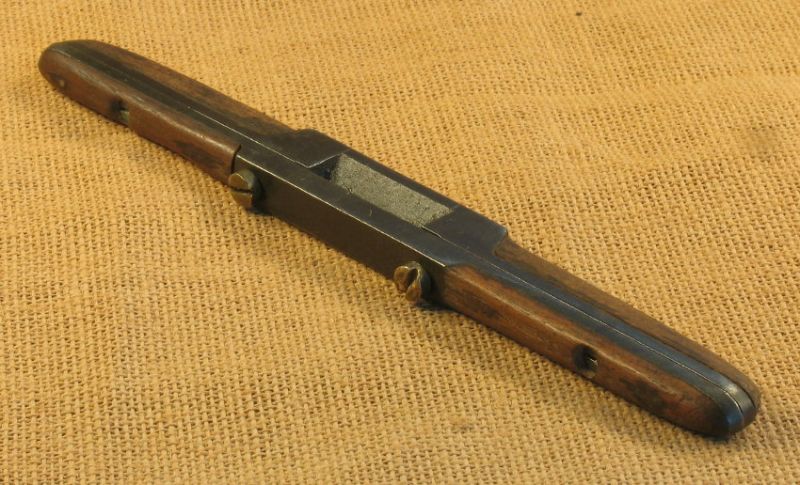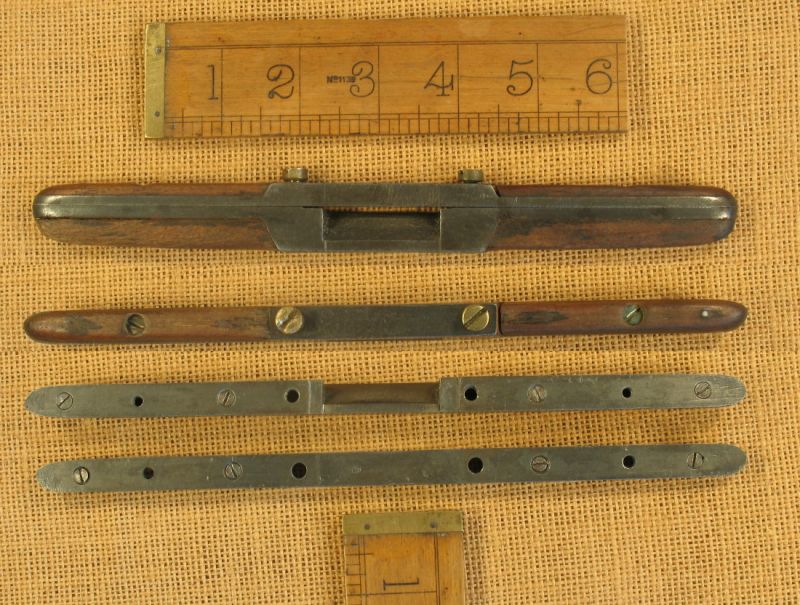bugbear
Established Member
I've sort of been meaning to make one of these, but never got round to it.
Yesterday, I bought what I suspect is a factory made one - and I had thought that Veritas were the first people to offer such a thing.
http://www.leevalley.com/US/wood/page.a ... 10&p=54883
The tool is nicely made, and very small and fine, at least compared to all the versions I've ever seen before.
The blade is 46 mm wide (1 13/16"); the tool is only 11mm thick (juts under half an inch),
and the overall length is 227mm (9"), weighing in at 198g (7 Oz).
The design is straight out of Salaman, with a 45 degree wear, "shoulders" either side of the shaving aperture to fix the blade, and through-screws both holding the tool together, and thereby holding the blade.
This tool is very finely made; in particular the robust metal has scales of wood held in place with screws (whose heads can be seen on the "inner-face" sub-shot, and the scales even have mitres where they butt up against the larger section of metal in the centre of the tool.
I thought at first this was a craftsman made tool, since I've never heard of a factory made devil, but I don't think this was made from stock with saw-and-file, due to the rough texture of the wear slope; I think it's a nicely finished forging, which implies factory.
However, having looked very carefully, I can find no trace of a maker's (nor owner's) mark.
So - does anyone know more about this tool?
Is it a chair maker's devil, or a scraper used in some other trade?
Who made it?

(montage of various angles)

For those new to this type of tool:
http://www.cornishworkshop.co.uk/scraper.html
http://www.primitiveways.com/pt-bow-scraper.html
BugBear (who could have sworn Alf had an article in a LV newsletter on these)
Yesterday, I bought what I suspect is a factory made one - and I had thought that Veritas were the first people to offer such a thing.
http://www.leevalley.com/US/wood/page.a ... 10&p=54883
The tool is nicely made, and very small and fine, at least compared to all the versions I've ever seen before.
The blade is 46 mm wide (1 13/16"); the tool is only 11mm thick (juts under half an inch),
and the overall length is 227mm (9"), weighing in at 198g (7 Oz).
The design is straight out of Salaman, with a 45 degree wear, "shoulders" either side of the shaving aperture to fix the blade, and through-screws both holding the tool together, and thereby holding the blade.
This tool is very finely made; in particular the robust metal has scales of wood held in place with screws (whose heads can be seen on the "inner-face" sub-shot, and the scales even have mitres where they butt up against the larger section of metal in the centre of the tool.
I thought at first this was a craftsman made tool, since I've never heard of a factory made devil, but I don't think this was made from stock with saw-and-file, due to the rough texture of the wear slope; I think it's a nicely finished forging, which implies factory.
However, having looked very carefully, I can find no trace of a maker's (nor owner's) mark.
So - does anyone know more about this tool?
Is it a chair maker's devil, or a scraper used in some other trade?
Who made it?

(montage of various angles)

For those new to this type of tool:
http://www.cornishworkshop.co.uk/scraper.html
http://www.primitiveways.com/pt-bow-scraper.html
BugBear (who could have sworn Alf had an article in a LV newsletter on these)




